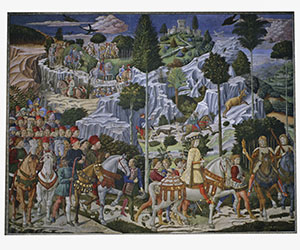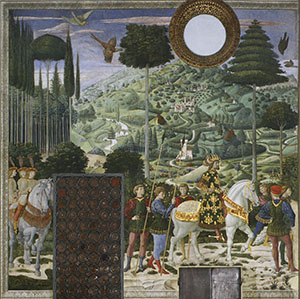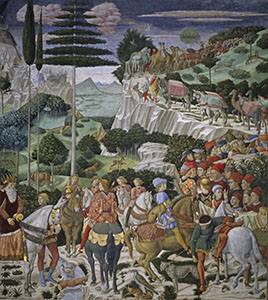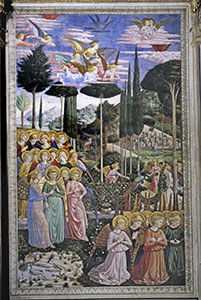
The Procession of the Magi, right-hand wall, Florence.

The Procession of the Magi, back wall, Florence.

The Procession of the Magi, left-hand wall, Florence.

Angels in Adoration, Chapel of the Magi, Florence.
By 1442, Pope Martin V had granted the Medici permission to build a private chapel. This chapel, dedicated to the Holy Trinity, was created by Michelozzo di Bartolomeo between 1449 and 1450 and finally completed in the spring of 1459, on the first floor of the private residence that the Medici family had built at around that time in Via Larga (now Via Cavour).
The chapel consists of a main, square room that leads, via a step, into a smaller, similar-shaped room, the scarsella (rectangular chancel), containing an altar and two minute vestries at the sides. The two rooms are separated by two pilasters topped with capitals of the Corinthian order. This space was originally occupied by a vestibule that ran along the wall of the entrance, directly opposite the altar, but the architecture underwent extensive alterations during the rebuilding work carried out in the seventeenth century by the Riccardi family who had taken possession of the building. A clear reminder of this transformation is the inward-facing projection in the south-west corner of the room (the current entrance) which disrupts the rational quadrangular shape of the space.
Piero de' Medici commissioned Benozzo Gozzoli, who had returned from Rome in 1459, to decorate the walls of this chapel. This work was sure to have begun after April, that is to say after Cosimo il Vecchio (Cosimo the Elder) had hosted Pope Pius II Piccolomini, Galeazzo Maria Sforza and Sigismondo Malatesta at the new residence. At that time, as contemporary sources document, only the inlaid marble floor, the carved, gilded and painted wooden ceiling and the altarpiece by Filippo Lippi depicting the Adoration of the Child were visible. The latter was replaced with a copy produced by the artist himself at his studio and the original is now housed in the Staatliche Museen in Berlin.
The iconographic program of the frescoes was suggested by Piero de' Medici himself with the assistance of his friend and confidant Roberto Martelli. Benozzo probably planned the work in the early summer and had to proceed swiftly, as can be deduced from correspondence between the painter and his illustrious patron in which assurances were given that the work would be completed by Christmas of that year.
The main subject of this cycle is the Procession of the Magi, which occupies three walls of the main room and is accompanied by frescoes portraying the Shepherds awaiting the announcement above the doors of the small vestries. The walls of the small scarsella (rectangular chancel) are decorated with the Angels in adoration and the symbols of the Four Evangelists behind the altar (although, due to later tampering, these were reduced to two - the Eagle of Saint John and the Angel of Saint Matthew). However, the narrative begins outside the room, specifically above the door leading from the small vestibule to the chapel where the Agnus Dei is depicted.
The journey begins in Jerusalem, which Benozzo perhaps likened to Mugello, from which the Medici originally hailed, and unfolds towards Bethlehem, in this case towards a panel inside the scarsella (rectangular chancel). The Magi, each of whom occupies one of the walls of the main room, are represented in the traditional manner. Indeed, Gaspar, the youngest, is dressed in white while Balthazar, in green attire, is a dark-skinned man of mature age, and Melchoir, clad in red, is the eldest and leads the procession. Recognizable among this noble parade were portraits of illustrious figures associated with the Medici family and, in particular, those who had attended the Council of Florence between the Greek and Latin Churches in 1439. Thus, on the east wall featuring Gaspar (or perhaps an idealised portrait of the then still very young Lorenzo the Magnificent), followed by Lorenzo's father Piero and grandfather and pater patriae Cosimo, Sigismondo Malatesta and Galeazzo Maria Sforza are also depicted, lords of Rimini and Milan respectively. Behind them is a procession of philosophers, including the humanists Marsilio Ficino and Cristoforo Landino, and Benozzo himself, rendered immortal here, wearing his characteristic red beret.
On the south wall, Melchoir, riding a white mule in the traditional iconographic depiction of Christ's arrival in Jerusalem, represents Joseph II, Patriarch of Constantinople. Finally, on the west wall, Byzantine Emperor John VIII Palaeologus is recognisable in the figure of Balthazar.
The extraordinary complexity of the scenes highlights Benozzo's sophisticated technical ability. Indeed, the predominantly wet plaster painting includes various details added after the plaster had dried, allowing the artist to work with meticulous care on the rendering of the precious jewels, sumptuous fabrics, horse trappings, fruit-laden trees, blossoming meadows, vibrant plumage of birds and multicoloured wings of angels. To achieve such magnificent effects, the artist used rare and costly materials such as lapis lazuli for blue deep waters, gleaming lacquers and pure gold leaves that shone in the darkness and candle-lit half-light.
There is an unusual iconographic feature here: the procession does not continue as far as the manger. Indeed, the adoration of the Child Jesus is restricted to the observers in the room, who come to pray before the altar where a painting produced by Filippo Lippi's studio is placed. The painting depicts the Virgin and Child, God the Father and the Holy Ghost, the concept of the Holy Trinity and the central mystery of Christian faith and life. At the time these frescoes were painted, the Western Church held the dogma that the Holy Ghost proceeded from the Father and the Son, a concept that contrasted with the belief of the Eastern Orthodox Church that the Holy Ghost emanated from God the Father alone. This representation reflected the debate on the principles established during the Council of Churches held in Florence in 1439 where it was established that "The Holy Ghost has his nature and subsistence at once from the Father and the Son and […] proceeds eternally from both as from one principle and through one spiration […]".
Recent studies have also identified in Benozzo's representation of the procession a specifically humanistic interpretation of the time, namely the "passage of Byzantine tradition in all its cultural and artistic splendour into the Western world. Perhaps the most rousing aspect of it is the authentic group portrait which clearly indicates a specific section of the Council: the Platonists and the most powerful members of the Philo-Byzantine clan." (translation from S. Ronchey, The Enigma of Piero, 2006).
Serena Nocentini